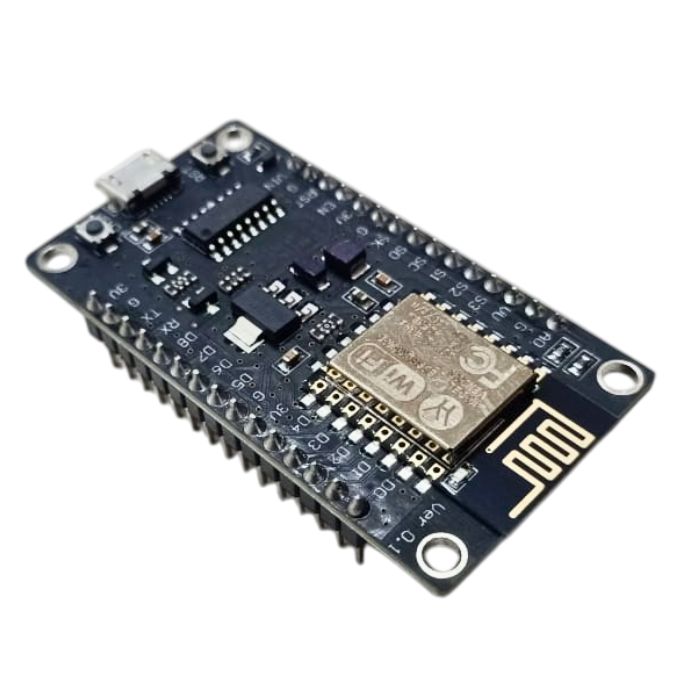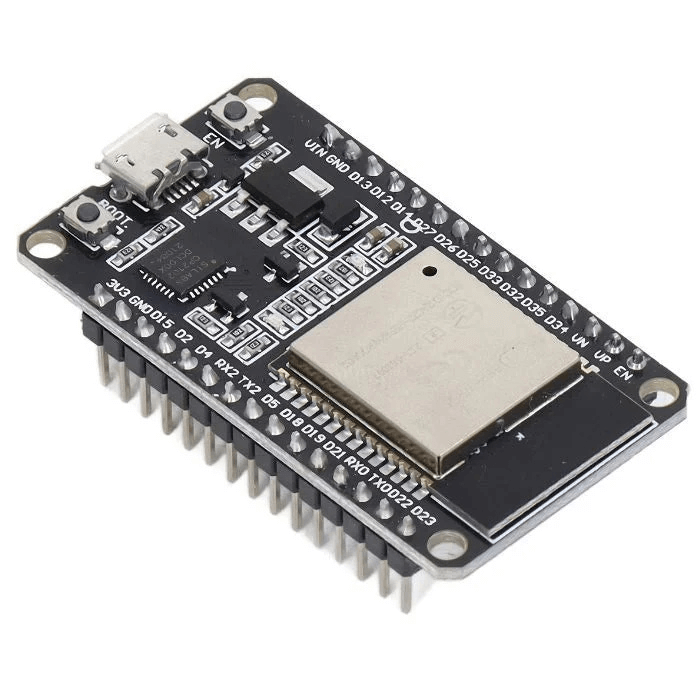NodeMCU ESP8266 AMICA CP2102 WiFi Development Board
Presenting you with the NodeMCU ESP8266 WiFi development board. It is designed to cater to a wide range of wireless applications.
This versatile NodeMCU board is equipped with the AMICA-CP2102 driver. It is interactive and programmable, with hardware IO that is reminiscent of Arduino.
The NodeMCU ESP8266 board features a convenient micro USB slot. One of the standout features of the board is its ability to provide seamless internet connectivity to your embedded projects, which makes it perfect for Internet of Things (IoT) applications.
With an onboard voltage regulator and 10 GPIO pins, this development board is designed for quick and hassle-free setup. It's an open-source platform, often programmed using the user-friendly Lua language.
The ESP8266 NodeMCU powered by the ESP8266 WiFi Module chip with the ESP-12 SMD footprint, is well-equipped with 4MB flash memory.
Explore the wide range of ESP Modules & Development Board
Download the ESP8266 Datasheet
NodeMCU ESP8266 Pinout:
ESP32 vs ESP8266 Comparison Table:
| Feature |
ESP8266 AMICA

|
ESP8266 Lolin

|
ESP32

|
| MCU |
Xtensa Single-core 32-bit L106 |
Xtensa Single-core 32-bit L106 |
Xtensa Dual-Core 32-bit LX6 (600 DMIPS) |
| Wi-Fi |
802.11 b/g/n (HT20) |
802.11 b/g/n (HT20) |
802.11 b/g/n (HT40) |
| Bluetooth |
- |
- |
Bluetooth 4.2 and BLE |
| Typical Frequency |
80 MHz |
80 MHz |
160 MHz |
| SRAM |
- |
- |
? |
| Flash |
? (Usually 4MB) |
? (Usually 4MB) |
? |
| GPIO |
11 (usable) |
11 (usable) |
34 |
| PWM (Hardware/Software) |
None / 8 channels |
None / 8 channels |
None / 16 channels |
| SPI / I2C / I2S / UART |
2 / 1 / 2 / 2 |
2 / 1 / 2 / 2 |
4 / 2 / 2 / 2 |
| ADC Resolution |
10-bit |
10-bit |
12-bit |
| CAN Interface |
- |
- |
? |
| Ethernet MAC Interface |
- |
- |
? |
| Working Temperature |
-40ºC to 125ºC |
-40ºC to 125ºC |
-40ºC to 125ºC |
| Price (Approx.) |
₹207 |
₹165 VIEW
|
₹354 VIEW
|
Read our blog: What is Nodemcu ESP8266.
Applications:
With this, we can Control Devices using an Android Phone over WiFi. Few generic applications would be in
- Internet Smoked Alarm
- VR Tracker
- Octopod
- Serial Port Monitor
- ESP Lamp
- Incubator Controller
- IoT home automation
- Security Alarms
1. How do I install NodeMCU ESP8266 drivers in Arduino IDE?
Start Arduino IDE.
Open Boards Manager from Tools > Board menu and find the ESP8266 platform.
Select the version you need from a drop-down box.
Click the install button.
Don't forget to select your ESP8266 board from the Tools > Board menu after installation.
2. What is NodeMCU Amica?
This development board is based on ESP8266 and is integrated with an onboard CP2102 USB-TTL converter. It is an open-source firmware and development platform that helps you to prototype your IoT projects and bring them to life. This board is equipped with an onboard voltage regulator and 10 GPIO pins which help you power up your development board in the fastest way possible.
3. What are the uses of it?
With this, we can control devices and appliances using Android phones over WiFi. A few generic applications include Internet Smoke Alarm, VR, Tracker, Octopod, Serial Port Monitor, ESP Lamp, Incubator, Controller, IoT home automation, and Security Alarms.
4. How do I know if my board is working?
Clear the serial monitor's output and change the baud rate to 74880. Then, press the reset button.
5. What microcontroller does NodeMCU ESP8266 use?
The NodeMCU ESP8266 features the ESP8266 WiFi microcontroller, which is a low-power system-on-chip (SoC) with integrated Wi-Fi. It provides sufficient processing power for IoT projects, sensor interfacing, and lightweight web server applications.
6. How much flash memory is included?
This ESP8266 development board comes with 4MB of flash memory, allowing storage of programs, Wi-Fi credentials, and project data. The ample memory supports complex IoT applications and firmware updates.
7. Is it compatible with Arduino IDE?
Yes, the NodeMCU ESP8266 development board is fully compatible with the Arduino IDE, making programming and uploading code straightforward. Developers can use standard Arduino libraries to control sensors, actuators, and Wi-Fi communication for smart IoT projects.
8. What communication interfaces does it support?
The ESP8266 development board supports multiple communication interfaces, including UART, SPI, I2C, and PWM. These interfaces allow connection to sensors, modules, displays, and other peripherals for home automation, robotics, and IoT experiments.
9. What projects can I build with NodeMCU?
With the NodeMCU ESP8266 WiFi development board, you can build a wide range of IoT projects, such as smart home systems, Wi-Fi weather stations, remote sensors, LED controllers, and web-connected automation systems. Its compact design and Wi-Fi capabilities make it ideal for both beginner and advanced IoT applications.



